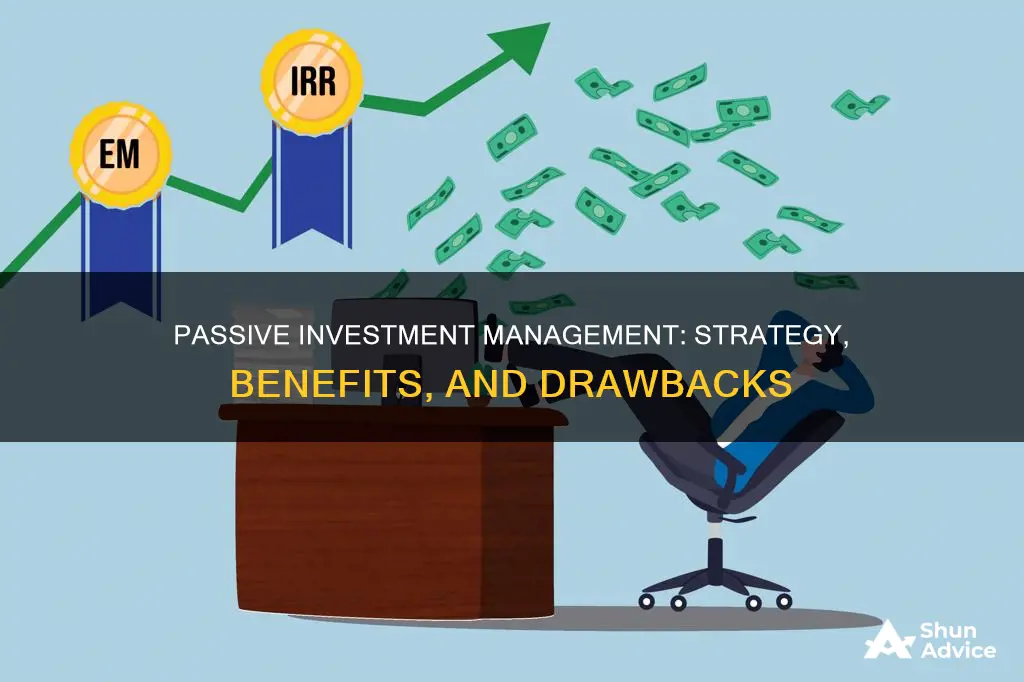
Passive investment management, also known as passive investing, is a long-term investment strategy that aims to mirror the performance of a market index, such as the S&P 500, by investing in a basket of assets. This approach seeks to reduce costs and simplify the investment process by eliminating the need for active stock selection and market timing. Instead of actively picking individual stocks, passive investors purchase securities that replicate a chosen market index, holding them for the long term. This strategy is often implemented through mutual funds or exchange-traded funds (ETFs) that track specific indices.
What You'll Learn
- Passive investment management is a long-term strategy
- It aims to reduce costs by minimising buying and selling
- Passive investment management is the opposite of active management
- Passive investment management is associated with mutual and exchange-traded funds
- Passive investment management is based on the Efficient Market Hypothesis

Passive investment management is a long-term strategy
Passive investment management is a popular strategy due to its potential for strong returns over the long term. By minimising the costs associated with fund management and reducing the amount of buying and selling, passive investors aim to maximise their returns. This approach is supported by the Efficient Market Hypothesis (EMH), which states that market prices fully reflect all available information, rendering individual stock-picking futile.
One of the key advantages of passive investment management is its low-maintenance nature. As a passive investor, there is no need to constantly track the performance of your investments or try to predict market winners and losers. Instead, you ride the wave of the market's performance. This strategy also offers steady returns, with passive funds historically outperforming active funds over long periods.
Additionally, passive investment management often results in lower fees for investors. Passive funds tend to have lower expense ratios since they do not require as much buying and selling as active funds. This can lead to significant cost savings over time.
Another benefit of passive investment management is lower capital gains taxes. By holding assets for the long term, passive investors pay less in taxes, as capital gains taxes are typically incurred when selling shares for a profit.
However, one of the limitations of passive investment management is the potential for limited investment options. When investing in an index fund or buying an ETF, investors cannot handpick each investment or easily drop companies they believe are not worthwhile. The goal of passive investing is to match the market average, so above-market returns may be less likely.
In conclusion, passive investment management is a long-term strategy that offers a range of benefits, including lower fees, lower taxes, and steady returns. It is a popular choice for investors seeking a more hands-off approach to building wealth over time.
Flash Estimates: Investment Management's Quick Insights
You may want to see also

It aims to reduce costs by minimising buying and selling
Passive investment management is a strategy that aims to maximise returns by reducing the costs associated with buying and selling securities. This is achieved by investing in a mutual fund or exchange-traded fund (ETF) that mirrors a market index, such as the S&P 500. This passive strategy removes the need for fund managers to actively select individual securities, simplifying the portfolio construction process and reducing fees triggered by frequent trading.
The passive approach to investment management focuses on long-term wealth accumulation by minimising buying and selling activity. This strategy, also known as "buy-and-hold", involves holding securities for extended periods, allowing investors to benefit from compound growth over time. By avoiding frequent trading, passive investors reduce transaction fees, commissions, and taxable capital gains, minimising overall investment costs.
Index investing is a common form of passive investment management. This strategy involves investors purchasing a representative benchmark, such as the S&P 500 index, and holding it for the long term. Index funds, which are commonly used for this strategy, aim to replicate the performance of a specific market index. This passive approach eliminates the need for fund managers to actively hunt for investments, as they simply mirror the index's holdings.
The benefits of passive investment management include reduced costs, simplicity, and tax efficiency. By minimising buying and selling, passive investors avoid the higher management fees and transaction costs associated with active management. Passive funds also benefit from larger average sizes, leading to economies of scale that further lower relative costs. Additionally, the buy-and-hold approach of passive investment management results in lower taxable capital gains, as assets are held for the long term.
However, one potential drawback of passive investment management is the lack of flexibility. Passive fund managers are typically restricted from using defensive strategies, such as reducing their position in shares of particular securities, even if they anticipate a decline in value. Additionally, passive funds are limited to a specific index or predetermined set of investments, providing less opportunity for customisation compared to active management.
Portfolio Net Assets: A Concern for Investors?
You may want to see also

Passive investment management is the opposite of active management
Passive investment management is a reference to index funds and exchange-traded funds that replicate an established index. This type of management is based on the belief that markets incorporate and reflect all information, making individual stock-picking futile. As a result, the best strategy is to invest in index funds, which have historically outperformed actively managed funds.
Passive investment management is often less expensive and complex than active management. It involves lower fees, as there is no need for costly research, and reduced trading costs due to less frequent buying and selling. Passive investing also simplifies the portfolio construction process and is more tax-efficient due to the buy-and-hold strategy.
However, passive investment management may result in smaller potential returns compared to active management. It offers limited investment options as investors cannot handpick each investment. Additionally, passive funds rarely beat the market and usually return slightly less due to operating costs.
In summary, passive investment management is a long-term strategy that aims to mirror market performance, reduce costs, and provide diversification. It is a popular approach, especially for investors seeking lower fees and a more hands-off approach, while active management involves more frequent trading, higher fees, and the potential for higher returns.
Passive Investment Portfolio: Strategy for Long-Term Wealth
You may want to see also

Passive investment management is associated with mutual and exchange-traded funds
Passive investment management is a strategy that aims to maximise returns by minimising the costs of buying and selling securities. It is often associated with mutual and exchange-traded funds (ETFs).
Passive investment management is a style of management where a fund's portfolio mirrors a market index. It is the opposite of active management, where fund managers attempt to beat the market with various investment strategies and buying or selling decisions. Passive management is a reference to index funds and ETFs that mirror an established index, such as the S&P 500.
Passive investment management is typically done by investing in mutual or exchange-traded funds that mimic the index's holdings, either exactly or approximately. This means that fund managers do not need to actively hunt for investments; they simply buy and sell the investments that their target benchmark trades. This results in lower fees for investors compared to actively managed funds.
Index investing is a common form of passive investment management. With this strategy, investors seek to replicate and hold a broad market index. Index funds, which are a type of mutual fund, are commonly used for this purpose. They provide investors with a simple and easy way to invest in a chosen market because they aim to track an index.
ETFs are another popular vehicle for passive investment management. These are open-ended, pooled, registered funds that are traded on public exchanges. A fund manager manages the underlying portfolio of an ETF, tracking a particular index or indices. ETFs offer investors benefits such as easy trading, low management fees, tax efficiency, and the ability to leverage using borrowed margin.
Overall, passive investment management associated with mutual and exchange-traded funds offers a cost-effective approach for investors seeking to mirror the performance of a market index. By reducing the fees and transaction costs associated with active management, passive investment management can enhance returns for long-term investors.
Understanding the Components of a Successful Investment Portfolio
You may want to see also

Passive investment management is based on the Efficient Market Hypothesis
Passive investment management is a long-term strategy for building wealth by buying securities that mirror stock market indexes and holding them for the long term. It is based on the Efficient Market Hypothesis (EMH), which was developed at the Chicago Graduate School of Business in the 1960s by Eugene Fama, a professor of economics at the University of Chicago.
The EMH demonstrates that no active manager can beat the market for long, as their success is only a matter of chance. It states that markets at all times incorporate and reflect all information, rendering individual stock-picking futile. As a result, the best investing strategy is to invest in index funds, which have historically outperformed actively managed funds.
Passive management is associated with mutual and exchange-traded funds (ETFs), where a fund's portfolio mirrors a market index. It is the opposite of active management, where fund managers attempt to beat the market with various investing strategies and buying/selling decisions. Passive management is a reference to index funds and ETFs that mirror established indices, such as the S&P 500.
Followers of passive management believe in the EMH and its implications for investing strategies. The hypothesis maintains that market prices fully reflect all available information and expectations, so current stock prices are the best approximation of a company's intrinsic value. It further suggests that it is impossible to consistently 'beat the market' through active management, although this interpretation is not universally accepted.
Passive investment management aims to maximise returns by minimising the costs of buying and selling securities. It is a popular strategy, with many investors satisfied by duplicating market returns instead of trying to beat them. It is also less expensive and complex than active management and often produces superior after-tax results over medium to long time horizons.
Workplace Savings and Investment Plans: What You Need to Know
You may want to see also
Frequently asked questions
Passive investment management is a long-term strategy for building wealth by buying securities that mirror stock market indexes and holding them for a long period of time.
In active investment management, investors research individual companies and buy and sell stocks in an attempt to beat the stock market. In passive investment management, investors buy a basket of assets and try to mirror what the stock market is doing.
Passive investment management can lead to lower maintenance, lower fees, lower capital gains taxes, and lower risk.
Passive investment management may lead to limited investment options and may not result in above-market returns.
Two common passive investment strategies are buying index funds and exchange-traded funds (ETFs).







